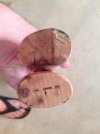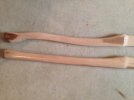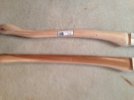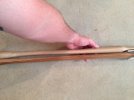- Joined
- Sep 11, 2012
- Messages
- 1,036
I'd like to know, from experience, how important grain alignment actually is in axe handles?
In a perfect world, I know the grain would like to be running in line with the blade.
How bad is it to have a grain pattern off from parallel or even perpendicular to the blade edge?
What can happen?
Reason I ask, I have no where near me to buy handles from so I order everything. I recently ordered two handles, asking for premium handles, but I'm less than pleased with what I received.
I will be placing a light 1 3/4 head on a 28" handle. I know it's a light head for that length but I really like the feel.
I ordered one curved boys axe handle and one straight single bit handle.
The curved handle has great alignment but has slight cracks in the "butt" (bottom) of the handle. (Not sure if its a big issue)
The Straight handle has great wood, all sap wood, BUT the grain runs straight perpendicular to the blade edge.
Would the bad grain alignment be a bad thing with the handle or should I go with the handle with good alignment but slight cracks?
Thoughts?
In a perfect world, I know the grain would like to be running in line with the blade.
How bad is it to have a grain pattern off from parallel or even perpendicular to the blade edge?
What can happen?
Reason I ask, I have no where near me to buy handles from so I order everything. I recently ordered two handles, asking for premium handles, but I'm less than pleased with what I received.
I will be placing a light 1 3/4 head on a 28" handle. I know it's a light head for that length but I really like the feel.
I ordered one curved boys axe handle and one straight single bit handle.
The curved handle has great alignment but has slight cracks in the "butt" (bottom) of the handle. (Not sure if its a big issue)
The Straight handle has great wood, all sap wood, BUT the grain runs straight perpendicular to the blade edge.
Would the bad grain alignment be a bad thing with the handle or should I go with the handle with good alignment but slight cracks?
Thoughts?





